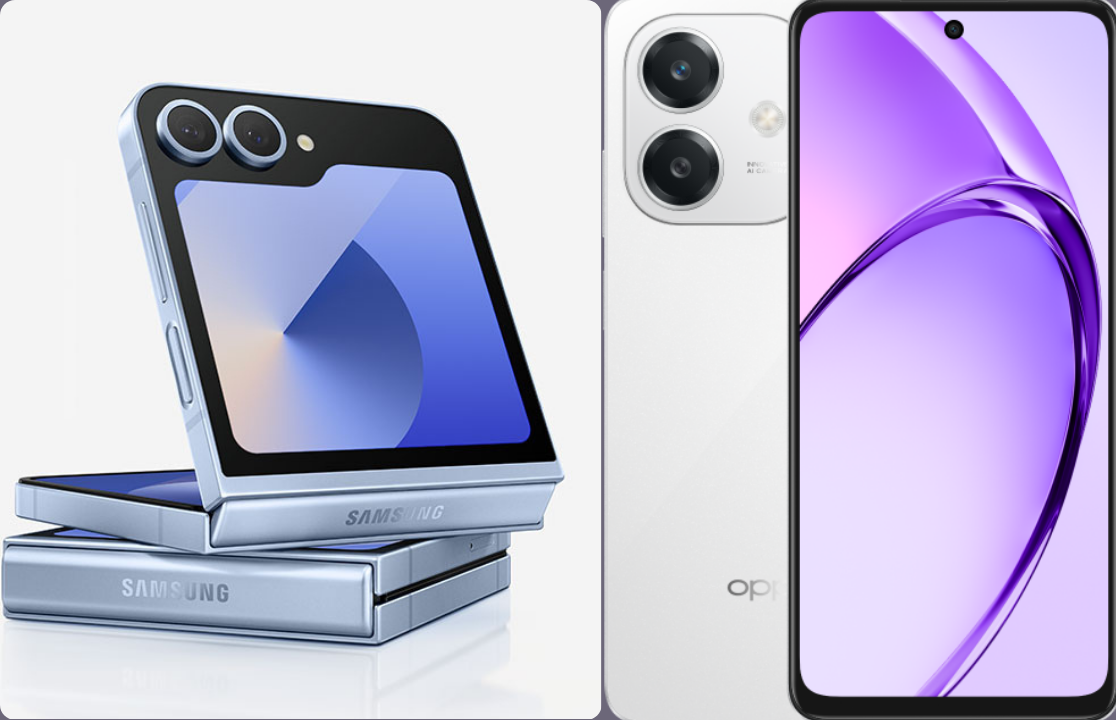As the smartphone market continues to evolve rapidly, Samsung, Oppo, and Xiaomi have emerged as three of the most dominant players globally. Each brand has carved its niche, offering cutting-edge technology and innovation that pushes the boundaries of mobile performance. In 2025, these companies are battling it out with their latest flagship releases, offering consumers a variety of powerful devices tailored to different needs and budgets.
This article will provide an in-depth comparison of the flagship smartphones from Samsung, Oppo, and Xiaomi, highlighting their key features, strengths, and differences. We’ll explore their design, performance, camera technology, battery life, software experience, and value for money to help you decide which device is right for you.
1. Samsung Galaxy S25 Ultra: Leading with Innovation
Samsung has long been at the forefront of mobile innovation, and the Galaxy S25 Ultra, launched in early 2025, is no exception. The device showcases the very best that Samsung has to offer, combining high-end hardware with cutting-edge software enhancements.
Key Features:
Design: The Galaxy S25 Ultra retains Samsung’s signature Dynamic AMOLED 2X display, now with a 6.9-inch edge-to-edge design and 120Hz adaptive refresh rate. The display is protected by the latest Gorilla Glass Victus 3, making it highly durable.
Performance: Powered by the Exynos 2500 (or Qualcomm Snapdragon 8 Gen 4 in some regions), the S25 Ultra boasts ultra-fast performance, making it ideal for multitasking, gaming, and intensive applications.
Camera: The camera setup remains a highlight, with a 200MP primary sensor, a 10MP periscope telephoto lens with 10x optical zoom, and a 12MP ultra-wide camera. Samsung’s advancements in AI-powered image processing deliver exceptional low-light performance and more accurate color reproduction.
Battery Life: Equipped with a 5,500mAh battery and 65W fast charging, the Galaxy S25 Ultra ensures that users have enough power for a full day of use, with the added convenience of reverse wireless charging.
Software: The device runs on One UI 7.0 based on Android 15, featuring new privacy controls, enhanced customization options, and deeper integration with Samsung’s ecosystem, including Galaxy Watch and Galaxy Buds.
Strengths:
Industry-leading display quality.
Best-in-class camera system with improved AI-driven photography.
Long-lasting battery with fast charging options.
Weaknesses:
Higher price point compared to competitors.
The large form factor may not be comfortable for all users.
2. Oppo Find X7 Pro: Sleek Design with a Focus on Imaging
Oppo’s Find X7 Pro is designed for consumers who prioritize photography and sleek design. Known for its innovative camera technology and stunning design language, the Find X7 Pro is a device that balances style with substance.
Key Features:
Design: The Find X7 Pro is crafted with a ceramic body and a curved 6.8-inch AMOLED display, offering a refresh rate of 144Hz for smoother animations. Its minimalist design and slim profile make it a standout in terms of aesthetics.
Performance: Oppo uses the Qualcomm Snapdragon 8 Gen 4 chipset, coupled with up to 16GB of RAM and 1TB of storage, ensuring top-tier performance for gaming and productivity.
Camera: The Find X7 Pro boasts an 80MP main camera with a custom Sony sensor, co-developed with Hasselblad. The partnership with Hasselblad continues to improve image quality, especially in portrait and landscape photography. The phone also features an impressive 50MP ultra-wide lens and a 32MP telephoto lens.
Battery Life: With a 5,000mAh battery and 80W SuperVOOC charging, the Find X7 Pro can be fully charged in just 25 minutes, making it one of the fastest-charging phones on the market.
Software: Oppo’s ColorOS 14, built on Android 15, offers a highly customizable user interface with new widgets, gestures, and improved privacy controls.
Strengths:
Superior camera performance, particularly in photography.
Elegant design with premium materials.
Industry-leading fast charging technology.
Weaknesses:
The software experience, while customizable, may not appeal to all users.
Lacks some features found in Samsung’s ecosystem, like S Pen integration or Dex mode.
3. Xiaomi Mi 15 Ultra: The Powerhouse of Performance
Xiaomi continues its mission to deliver high-performance smartphones at competitive prices. The Mi 15 Ultra, launched in early 2025, offers flagship-level specifications at a fraction of the cost of competitors, making it a popular choice for tech enthusiasts who want the best value for their money.
Key Features:
Design: The Mi 15 Ultra features a 6.9-inch LTPO AMOLED display with a 144Hz refresh rate. Its build quality, with an aluminum frame and matte glass back, feels premium despite its relatively lower price compared to Samsung and Oppo.
Performance: Xiaomi equips the Mi 15 Ultra with the Qualcomm Snapdragon 8 Gen 4 processor, combined with up to 18GB of RAM and 1TB of storage, making it one of the most powerful devices on the market.
Camera: The camera system includes a 108MP primary camera, a 48MP ultra-wide lens, and a 20MP periscope telephoto lens with 5x optical zoom. Xiaomi’s AI image processing enhances photo clarity and low-light performance, although it still trails behind Samsung’s and Oppo’s camera innovations.
Battery Life: Xiaomi packs a 6,000mAh battery into the Mi 15 Ultra, offering 120W HyperCharge technology that can fully charge the device in just 20 minutes. It also supports 50W wireless charging, making it a leader in battery technology.
Software: The device runs on MIUI 16, based on Android 15, offering a wide range of customization options, including enhanced multitasking and security features.
Strengths:
Excellent performance and hardware specifications at a competitive price.
Industry-leading charging technology.
Large battery for extended use.
Weaknesses:
The camera system, while impressive, doesn’t quite match the overall imaging quality of Samsung or Oppo.
MIUI is not as refined as other Android skins, and some users may find it less user-friendly.
4. Key Areas of Competition:
a. Display Quality
Samsung remains the leader with its Dynamic AMOLED 2X displays, known for their vivid colors, high contrast, and adaptive refresh rates.
Oppo’s Find X7 Pro offers a smooth and immersive display experience with its 144Hz AMOLED screen.
Xiaomi’s Mi 15 Ultra also offers a high refresh rate, but its display, while vibrant, falls just short of the color accuracy and brightness found on the Samsung Galaxy S25 Ultra.
b. Camera Innovation
Samsung’s Galaxy S25 Ultra takes the lead in overall camera performance, particularly with its 200MP sensor and powerful zoom capabilities.
Oppo’s collaboration with Hasselblad gives the Find X7 Pro an edge in photography, particularly for portraits and natural lighting conditions.
Xiaomi’s Mi 15 Ultra offers a solid camera setup, but its AI-driven enhancements and processing are not as advanced as those in Samsung’s and Oppo’s flagships.
c. Battery and Charging
Xiaomi leads the pack with its 6,000mAh battery and 120W HyperCharge, offering the fastest charging speeds in the market.
Oppo’s 80W SuperVOOC fast charging is also impressive, but its battery size is smaller than Xiaomi’s.
Samsung offers respectable battery performance, but its charging speeds are slower than those offered by Oppo and Xiaomi.
d. Software and Ecosystem
Samsung’s One UI 7.0 provides the most polished software experience, with deep integration across Samsung’s ecosystem of devices, including wearables and home automation.
Oppo’s ColorOS 14 is highly customizable but may not appeal to all users.
Xiaomi’s MIUI 16 offers a wide range of features but can feel cluttered compared to Samsung’s streamlined interface.
Conclusion: Which Brand Comes Out on Top?
Choosing between Samsung, Oppo, and Xiaomi in 2025 depends largely on what you prioritize in a smartphone.
Samsung remains the leader for those seeking the best display and overall camera performance, especially for users who are already invested in the Samsung ecosystem.
Oppo is ideal for photography enthusiasts who value premium design and fast charging but prefer a device that’s a little more compact than Samsung’s Ultra series.
Xiaomi offers the best value for money, providing flagship-level performance and the fastest charging speeds on the market, making it the perfect choice for tech enthusiasts on a budget.
Ultimately, all three brands have stepped up their game in 2025, offering consumers more choices and innovations than ever before. As the competition between Samsung, Oppo, and Xiaomi intensifies

